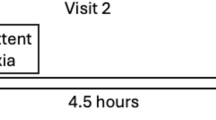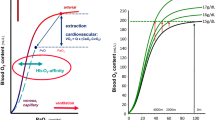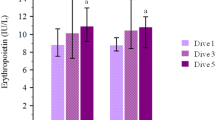Abstract
Hypoxia-induced increases in red blood cell production have been found in both altitude-adapted populations and acclimatized lowlanders. This process is mediated by erythropoietin (EPO) released mainly by the hypoxic kidney. We have previously observed high hemoglobin concentrations in elite breath-hold divers and our aim was to investigate whether apnea-induced hypoxia could increase EPO concentration. Ten healthy volunteers performed 15 maximal duration apneas, divided into three series of five apneas, each series separated by 10 min of rest. Apneas within series were separated by 2 min and preceded by 1 min of hyperventilation to increase apnea duration and arterial oxygen desaturation. When EPO concentration after serial apneas was compared to baseline values, an average maximum increase of 24% was found (P < 0.01). No changes in EPO concentration were observed during a control day without apnea, eliminating possible effects of a diurnal rhythm or blood loss. We therefore conclude that serial apneas increase circulating EPO concentration in humans.



Similar content being viewed by others
References
Andersson JP, Liner MH, Fredsted A, Schagatay EK (2004) Cardiovascular and respiratory responses to apneas with and without face immersion in exercising humans. J Appl Physiol 96:1005–1010
Balestra C, Germonpre P, Poortmans JR, Marroni A (2006) Serum erythropoietin levels in healthy humans after a short period of normobaric and hyperbaric oxygen breathing: the “normobaric oxygen paradox”. J Appl Physiol 100:512–518
Cahan C, Decker MJ, Arnold JL, Washington LH, Veldhuis JD, Goldwasser E, Strohl KP (1992) Diurnal variations in serum erythropoietin levels in healthy subjects and sleep apnea patients. J Appl Physiol 72:2112–2117
Cahan C, Decker MJ, Arnold JL, Goldwasser E, Strohl KP (1995) Erythropoietin levels with treatment of obstructive sleep apnea. J Appl Physiol 79:1278–1285
Choi JB, Loredo JS, Norman D, Mills PJ, Ancoli-Israel S, Ziegler MG, Dimsdale JE (2006) Does obstructive sleep apnea increase hematocrit? Sleep Breath 10:155–160
de Bruijn R, Richardson M, Haughey H, Holmberg H-C, Björklund G, Schagatay E (2004) Hemoglobin levels in elite divers, elite skiers and untrained humans. Abstract at the 30th annual meeting of EUBS, Ajaccio, France
Eckardt KU, Boutellier U, Kurtz A, Schopen M, Koller EA, Bauer C (1989) Rate of erythropoietin formation in humans in response to acute hypobaric hypoxia. J Appl Physiol 66:1785–1788
Erslev A (1953) Humoral regulation of red cell production. Blood 8:349–357
Ge RL, Witkowski S, Zhang Y, Alfrey C, Sivieri M, Karlsen T, Resaland GK, Harber M, Stray-Gundersen J, Levine BD (2002) Determinants of erythropoietin release in response to short-term hypobaric hypoxia. J Appl Physiol 92:2361–2367
Gooden BA (1994) Mechanism of the human diving response. Integr Physiol Behav Sci 29:6–16
Hoffstein V, Herridge M, Mateika S, Redline S, Strohl KP (1994) Hematocrit levels in sleep apnea. Chest 106:787–791
Imagawa S, Yamaguchi Y, Higuchi M, Neichi T, Hasegawa Y, Mukai HY, Suzuki N, Yamamoto M, Nagasawa T (2001) Levels of vascular endothelial growth factor are elevated in patients with obstructive sleep apnea–hypopnea syndrome. Blood 98:1255–1257
Jacobson LO, Goldwasser E, Fried W, Plzak L (1957) Role of the kidney in erythropoiesis. Nature 179:633–634
Julian CG, Gore CJ, Wilber RL, Daniels JT, Fredericson M, Stray-Gundersen J, Hahn AG, Parisotto R, Levine BD (2004) Intermittent normobaric hypoxia does not alter performance or erythropoietic markers in highly trained distance runners. J Appl Physiol 96:1800–1807
Jung K, Stolle W (1981) Behavior of heart rate and incidence of arrhythmia in swimming and diving. Biotelem Patient Monit 8:228–239
Klausen T, Poulsen TD, Fogh-Andersen N, Richalet JP, Nielsen OJ, Olsen NV (1996) Diurnal variations of serum erythropoietin at sea level and altitude. Eur J Appl Physiol Occup Physiol 72:297–302
Knaupp W, Khilnani S, Sherwood J, Scharf S, Steinberg H (1992) Erythropoietin response to acute normobaric hypoxia in humans. J Appl Physiol 73:837–840
Schagatay E, Andersson J (1998) Diving response and apneic time in humans. Undersea Hyperb Med 25:13–19
Schagatay E, van Kampen M, Andersson J (1999) Effects of repeated apneas on apneic time and diving response in non-divers. Undersea Hyperb Med 26:143–149
Schagatay E, van Kampen M, Emanuelsson S, Holm B (2000) Effects of physical and apnea training on apneic time and the diving response in humans. Eur J Appl Physiol 82:161–169
Wang GL, Semenza GL (1993) General involvement of hypoxia-inducible factor 1 in transcriptional response to hypoxia. Proc Natl Acad Sci USA 90:4304–4308
Zapol WM, Liggins GC, Schneider RC, Qvist J, Snider MT, Creasy RK, Hochachka PW (1979) Regional blood flow during simulated diving in the conscious Weddell seal. J Appl Physiol 47:968–973
Acknowledgments
We thank all subjects for their participation and Hanna Lemon, Ulrica Milling and Torborg Jonsson for assistance during the experiments. We also thank Prof. Thomas Palo for valuable comments on the paper. The study was supported by the Swedish National Center for Research in Sports (CIF) and the County Administrative Board of Västernorrland, Sweden.
Author information
Authors and Affiliations
Corresponding author
Rights and permissions
About this article
Cite this article
de Bruijn, R., Richardson, M. & Schagatay, E. Increased erythropoietin concentration after repeated apneas in humans. Eur J Appl Physiol 102, 609–613 (2008). https://doi.org/10.1007/s00421-007-0639-9
Accepted:
Published:
Issue Date:
DOI: https://doi.org/10.1007/s00421-007-0639-9




